Indiana and its Lithuanian Riviera
Northern Indiana was absorbed by suburban Chicago - "Lithuanian-American capital". So many Chicagoans have moved into the Lake Michigan coasts there that the area became known as the "Lithuanian Riviera" among the Lithuanian community. Most of the "Lithuanian Riviera" is in Indiana, but it stretches well into Michigan. In numerous towns Lithuanian memorials have been built and Lithuanian institutions created.
"Lithuanian Riviera" reached its apex as many Chicago Lithuanians have chosen this area for their holidays in the 1950s-1980s because of the area's dune-clad Lake Michigan coasts being similar to the Lithuania's top resort of Palanga, still a vivid memory for many Lithuanians who fled the Soviet Genocide. While the Lithuanian heritage sites and memorials in the area generally date to these times, the Lithuanian affinity for this area is older than that, with the pre-WW1 Lithuanian immigrants to Chicago already enjoying the "Lithuanian Riviera" in the summers back in the 1930s.
In the mid-20th century, typically, Lithuanian men used to arrive here to spend summer weekends, while the Lithuanian women and children would spend entire summers here (in those days, much fewer women worked and it used to be a common practice among all ethnicities). As they became older and retired, many have moved to "Lithuanian Riviera" full time. Moreover, as Lithuanian districts in Chicago disintegrated, some younger families have moved to this area and commute to Chicago every day, treating the "Lithuanian Riviera" as Chicago suburbs, making some of the area's towns and villages to be among the most Lithuanian in the entire USA.
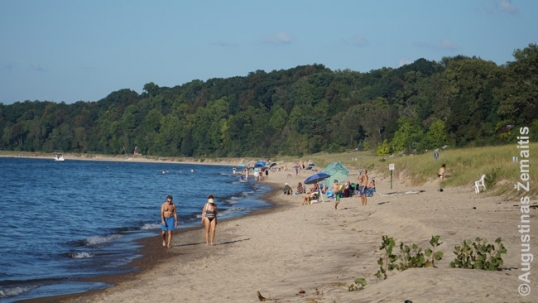
The beach at Union Pier resort
At the same time, however, Lithuanian Riviera gradually lost popularity as a vacation destination, as far-away destinations such as Florida, Hawaii, and the Caribbean became much more easily accessible (in terms of time and cost), while most women began to work, rendering the "pretty summer home for wife and kids" idea obsolete.
In addition to the laid-back lakeshore suburbs of "Lithuanian Riviera", Indiana's Lake Michigan shores also has several historic industrial cities that had strong Lithuanian heritage (Gary, East Chicago).

Lituanica park memorial stone in Beverly Shores
Lithuanian Riviera of Indiana - Beverly Shores, Michigan City
The heart of Lithuanians in Indiana and the whole "Lithuanian Riviera" is the resort town of Beverly Shores near the famous Indiana Dunes of Lake Michigan. 12,5% of its ~700 inhabitants are Lithuanians. In 1968 a local park was renamed after Lituanica plane; a symbolic memorial dedicated to Darius and Girėnas who piloted that aircraft in a doomed first air mail voyage across Atlantic also stands here in a middle of a pond (1971, author Juozas Bakis). It represents the broken wing of the downed Darius and Girėnas's aircraft "Lituanica". Beverly Shores also has a Lithuanian club, however, it has no building of its own.
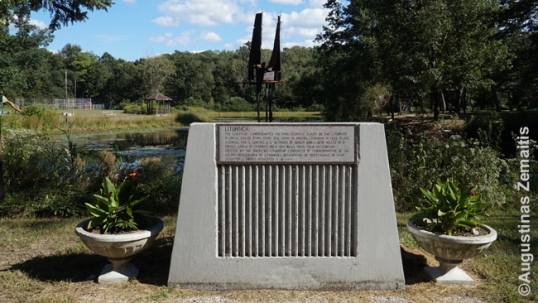
Lituanica Park in Beverly Shores
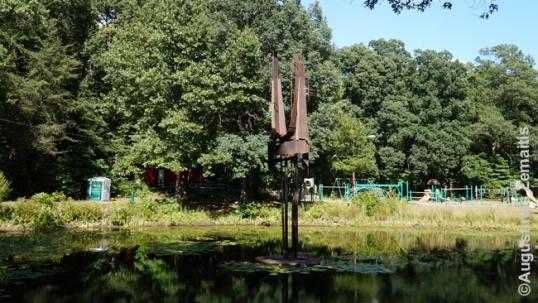
Lituanica memorial (broken wing) in the Lituanica Park of Beverly Shores
Beverly Shores is also unique among the US cities and towns in that, while it has no Lithuanian church, it has a Lithuanian mass celebrated in the local parish. As by the time Lithuanians moved into Beverly Shores many of them were older, they did not build their own church, however, they were able to make significant alterations to the St. Ann of the Dunes church in 1970 (originally, the church had been built in 1950). Its wings and the unique glass wall behind the altar were designed by a Lithuanian architect Erdvilas Masiulis (who also designed numerous homes in Beverly Shores) while its interior eventually received Lithuanian donations of Rūpintojėlis (traditional sculpture of a sad God) by Daugvila and an altar cross made of amber (a material traditionally associated with Lithuania).

St. Anne church of Beverly Shores with the Lithuanian amber cross visible, as well as Masiulis-designed window behind the altar that shows nature (God's creation)
Lithuanian atmosphere of Beverly Shores is also strengthened by the high number of traditional Lithuanian wooden crosses (UNESCO World Heritage artform) that adorn the local houses, as well as Lithuania names and symbols. Jurgis Daugvila, one of the most famous Lithuanian-American cross-crafters, had a home in Beverly Shores.

A private home with a Lithuanian cross in Beverly Shore
Historically, there were also numerous Lithuanian guesthouses. A lakeside heritage trail plaque that lists the town's historic guesthouses reveals that many of them were named in Lithuanian - either in names related to the Lithuanian seaside (Baltic, Nida, Palanga), or in anglicized Lithuanian surnames that were common among first wave migrants. Many of these guesthouses were demolished after 1970s as parts of the coastal dunes became protected and the government removed the houses built on top.

Plaque with the names of historic Beverly Shores guesthouses
In the nearby Michigan City International garden various sections are dedicated to various ethnicities. There is also a Lithuanian section. After spending decades of being quite derelict, the gardens were restored in the 2010s and now also host annual ethnic festivals, including a Lithuanian one. At the heart of the park's Lithuanian section is the historic Lithuanian presidents memorial, began in 1941 as interwar Lithuania's final president Antanas Smetona (who fled Lithuania to the USA in 1940) planted a tree there. Later, the Smetona's post has been joined by two more posts for the two other interwar Lithuanian presidents: Aleksandras Stulginskis and Kazys Grinius. Other ethnic gardens in Michigan City are dedicated to Poles, Romanians, Norwegians, Native Americans, Germans, and Scotts.
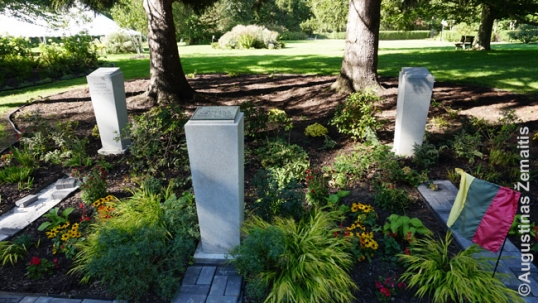
Lithuanian garden in Michigan City. Each post is for a president of Lithuania

Antanas Smetona plaque on one of the posts
Recently the Lithuanian section was expanded with a traditional Lithuanian chapel-post (a.k.a. Wayside shrine, koplytstulpis) that was donated by the Knights of Lithuania in 2016.
Lithuanian sites in the industrial cities of Gary, East Chicago and South Bend
The cities of Gary and EastChicago that are located between Chicago and the Lithuanian Riviera have a very different history: they were industrial powerhouses that housed many Lithuanians before the World Wars but became Black-majority since then, with nearly all Lithuanians leaving them behind.
Once Gary had a Lithuanian St. Casimir church (constructed, 1927, closed 1998) and St. Casimir school (located in the first church building, built 1918). Both buildings survive (1368 West 15th Avenue) and are now used for the same purposes by the Black-majority Power and Light church. In the church, two Lithuanian stained-glass windows survive. The one on the left side near the altar inscribed with letters "Moterų dovana" (a gift from women), while the one on the right "Vyrų dovana" (a gift from men). Those are the only two original stained-glass windows that survived the devastating fire of 1970 04 12. During its reconstruction after fire 1974, the new church has also received many other new stained glass windows by a famous designer A. Valeška, as well as a unique Lithuanian folk-inspired wooden artwork at its entrance (with a traditional Lithuanian sun-cross) and a wooden tower. None of those remain in the church after it was sold, however.

Gary St. Casimir Lithuanian church

Gary Lithuanian school (old church)
As most of Lithuanians have left the area and the church suffered a fire in 1970, the parishioners tried to relocate the parish to the suburbs and even got a donation promise for a lot as well as found a buyer for their church. Diocese, however, forbade the relocation, essentially condemning the parish to closure on the long run.
East Chicago also had its Lithuanian church (erected 1913, since demolished, formerly 3903 Main Street) and still has a street named after Lituanica airplane.
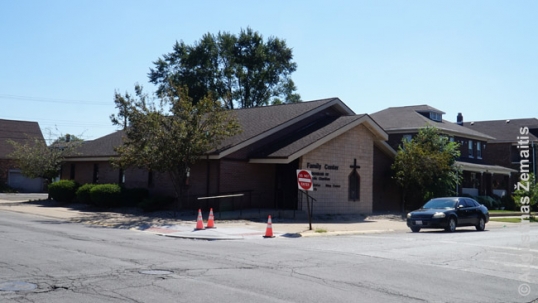
Location of the Lithuanian chucrh of East Chicago
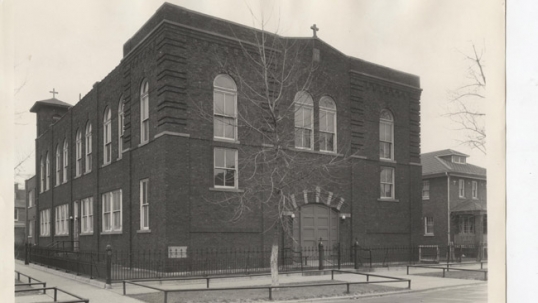
Now-demolished Lithuanian church of East Chicago. Image from Lithuanian Research Studies Center
Deeper inland, the industrial city of South Bend never had a strong Lithuanian community, however, one Lithuanian has made enough impact there to have a sculpture erected to him. That was Edvardas Kraučiūnas, brother of Feliksas Kraučiūnas (a basketball star who helped Lithuanians win the 1937-1939 European basketball championships). Like Feliksas, Edvardas was very capable in sports and coached the team of South Bend's Notre Dame University. With the importance Americans put on varsity sports, the university has erected sculptures for many of its famous coaches; a nearby street is named after Kriaučiūnas as well. However, instead of using the Lithuanian name "Edvardas Kriaučiūnas", the name "Moose Kraus" he adopted later is used. Kriaučiūnas adopted that name because, while he still was a player in the university, his own coach was unable to spell his Lithuanian name. Edvardas Kriaučiūnas (Moose Kraus) sculpture is sitting on a bench on the side of Notre Dame University's stadium.
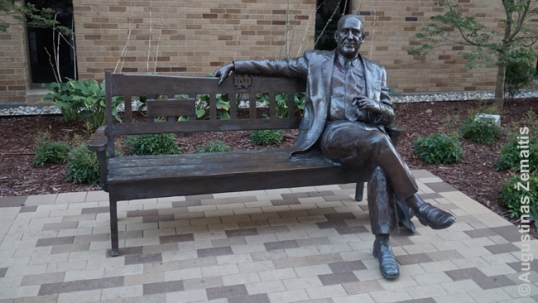
Edvardas Kriaučiūnas (Moose Kraus) sculpture in South Bend (Notre Dame university)
Union Pier and Michigan's Lithuanian Riviera
One of the most Lithuanian resort towns of the Lithuanian Riviera was Union Pier, which at one time had 7 Lithuanian resorts that would have hosted the Lithuanian men visiting from Chicago for weekends and Lithuanian women/children for prolonged times in summer. As these practices declined and many older Chicago Lithuanians bought their own summer homes in the Union Pier, just a single Lithuanian resort remained: Gintaras Resort on the Lake. However, this last one was also closed in 2019. The last remaining visibly Lithuanian vestige is now Milda Corner Market - a Lithuanian shop operating since 2001 and marked with a Lithuanian flag.
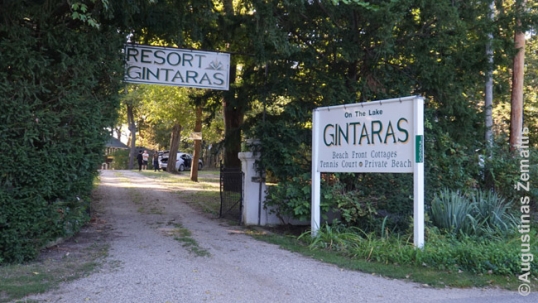
Gintaras Resort on the Lake sign prior to its closure
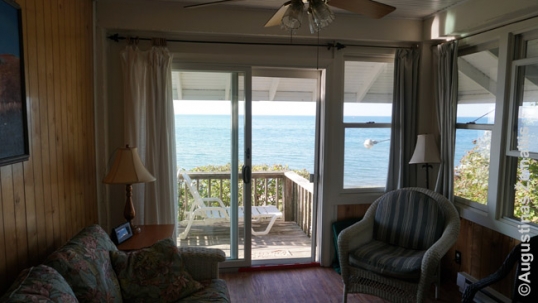
Gintaras Resort on the Lake room prior to its closure
One of the most famous Lithuanian resorts in the "Riviera" actually used to stand inland: that was the Tabor Farm that used to be owned by the Adamkus family (who later became the president of Lithuania) and attracted much of the Lithuanian-American elite. However, Tabor Farm has been sold and demolished since, leaving no traces.
The map
All the Lithuanian locations, described in this article, are marked on this interactive map, made by the "Destination Lithuanian America" expedition (click the link):
Interactive map of Lake Michigan southern shore Lithuanian heritage




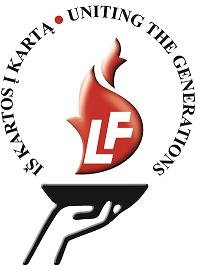

June 12th, 2015 - 14:50
This is a great collection of historic facts, an extensive fact sheet for young people interested in their heritage.
Is there any consideration in compiling a similar collection of Canadian communities which are numerous throughout the provinces, during all three waves of immigration?
July 8th, 2015 - 08:44
Hello, thank you. The information on Canadian Lithuanian heritage is already available at our website, click here.
June 13th, 2015 - 15:35
Augustinas, Yours is one very thorough paper about Lithuanian-Americans. I was disappointed to not read more about Jewish emigration from Lithuania, mostly, I believe from the first wave. Your country lost over 95% of its Jewish community to the Nazis. Did you know that 2/3’s of American Jews are from Eastern Europe and many of those from Lithuania?
June 17th, 2015 - 22:29
yes mate, we Lithuanians know that, but I do not know why, a lot of people forget to mention that..
July 8th, 2015 - 08:34
Thanks. The goal of Global True Lithuania website is not to document migration from Lithuania as such, but rather Lithuanian heritage abroad (i.e. buildings, plaques, parks, etc.). For heritage to be documented here, it has to have some association to Lithuania, such as its name, Lithuania-related architectural details, plaques detailing history of Lithuania or migration from it, the usage of building (historical or current) exclusively by a Lithuania-originated community.
While the number of Jewish migrants from Lithuania was indeed large, as my research has often pointed, it was common practice for Jewish emigrants from Lithuania to integrate into the Jewish communities at their place of destination without establishing a separate Lithuanian-Jewish community or leaving heritage anyhow related to Lithuania (the mere fact that emigrants from Lithuania participated in construction or development of the building is not enough for that building to be included in Global True Lithuania; if it would be otherwise, we would have to include also, for example, every building in USA designed by a Lithuanian architect, which would clearly be beyond our scope).
Of course, there are exceptions where Jews who emigrated from Lithuania has created something that could also be considered Lithuania’s heritage abroad, and we try to document them. For instance, the article on Boston includes an image and history of Vilna Shul, a synagogue named after the capital of Lithuania. I know of also Telshe Yeshiva in Cleveland and Ponevezh Yeshiva in Israel named after Lithuanian cities by Jews who once lived in Lithuania. These are on my plans to be added. If you know more similar locations, you are welcome to write in comments and they will be added to respective articles.
As for massive Jewish emigration before World War 1, you are correct; the emigration was such that Jewish share in Lithuania more than halved in decades before 1918. However, the idea that 95% of the remaining population were lost in 1940s alone is an often-cited oversimplification. Such a decline actually happened over the period a century. While the Holocaust was the largest post-WW1 loss-triggering event, there was much Jewish emigration after World War 1 as well. We provide census data on how the Lithuania’s Jewish numbers declined in the article Jews of Lithuania at our sister site. The decline between censae of 1923 and 1959 was around 88%; however, even in this period there were many who succesfully emigrated before the WW2 (1920s-1930s) or were helped to flee the Nazi occupation by righteous-among-nations people. USA was a regular destination of Jewish emigrants throughout the two centuries. However, USA was joined by South Africa and Palestine as popular destinations after World War 1. After World War 2 Lithuania still had ~25 000 Jews, most of whom emigrated afterwards (especially to Israel). If you have any information on Lithuania-related heritage in other places Lithuania’s Jews emigrated after World War 1, you are also welcome to provide it.
June 13th, 2015 - 18:08
Very impressive compilation on Lithuanians in America. There is so much left to learn about Lithuanian culture, and I appreciate your careful efforts to educate those who have not yet become fully involved within the community.
July 8th, 2015 - 08:42
Thank you
July 21st, 2015 - 14:24
Impressive amount of information. Congratulations. A correction on the Cleveland entry. St. George parish and Our Lady of Perpetual Help parish were both closed in 2009 and merged to form a new parish – St. Casimir. Although Bishop Lennon could have simply closed both existing Lithuanian parishes, he bent the rules of the diocesan reorganization and merged the geographically separated parishes into one, and appointed a Lithuanian (St. George parish pastor) priest to head the new parish. Tahnk you.
July 21st, 2015 - 18:04
Thanks for the corrections. This has been now clarified in the Cleveland page.
November 28th, 2015 - 14:51
Thanks for the almost thorough information. I picked up on the article reprinted in VYTIS (Knights of Lithuania magazine). With regards to Pennsylvania, I find it disappointing that you did not include St. Joseph Church in DuBois, PA, which is currently recognized as the oldest still-functioning Lithuanian church in the United States. The Erie Diocese is currently weighing what churches to close in Diocese and is anticipated to make an announcement in the Spring of 2016. Let’s hope St. Joseph’s doesn’t lose it’s current status among Lithuanian churches.
November 28th, 2015 - 23:27
Thank you. The information on Lithuanian communities worldwide here is a work-in-progress. Every few weeks additional locations are added. For example, Florida and Wisconsin were added recently. Pennsylvania has lots of Lithuanian heritage and so far only some regions of it are covered (namely Philadelphia, Pittsburgh and Southern Coal Region around Shenandoah). So, more places and information will be added over the time.
May 19th, 2017 - 17:37
Hallo. This is fantastic. Who knows if there is a hockeyrink close by. Lithuanian Boys would like to play there for a season. Please write back. Bernd Haake Nationalteam Coach
December 20th, 2017 - 08:50
Hello my family was members of that small church in gary indiana.my grandfather helped build it his name was simon baltrukonis and we lived across the street from the church.father urbanus was the priest it was the most beautiful church i ever neen in if u have any pics u can post would greatly appreciate ot thank you very much.
April 19th, 2018 - 21:55
In fact, we would very much so welcome anyone in Indiana to reach out to our school- we do lots of events, honor tradition and most importantly- enjoy each other’s company and make sure our kids grow up to love and be proud of their heritage! https://www.facebook.com/IndianapolioLituanistineMokykla/
September 10th, 2018 - 14:10
The Lithuanian Church in East Chicago was named St. Francis. It was not on Main St, but at 3803 Fir Street. It closed in 1987 and was demolished two years later.
September 13th, 2018 - 04:15
Thanks. The article will soon (in a couple of months) be updated as we visit the area ourselves as part of the project Destination Lithuanian America 2018
November 28th, 2018 - 15:39
Thank you,aciu, for such an impressive work of history. It is history alive since you are able to update and change based on new knowledge.
November 28th, 2018 - 18:33
Indeed. If you know additional Lithuanian sites – you are welcome to notify us about them and we will add them.
February 1st, 2019 - 05:52
My grandmother Baroness Teophillia Kazis Zlatarinskas used to take me to bob a link sp? in miller beach. This was a Lithuanian resort owned by her friend from the old days . I think ti was started in the 1930.s.
thank you
Mark
July 21st, 2022 - 18:02
There is a significant error in the beginning of this article where it says that the northern Indiana “Lithuanian Riviera” began in the 1950s and 1960’s. It was instead in the 1930’s and 1940’s that Chicago’s Lithuanians established a vacation destination in Beverly Shores, Indiana with summer resorts/rentals there which were even advertised in Chicago’s Lithuanian newspapers.
When the post World War II Lithuanian arrivals started coming to Beverly Shores in the summers of the early 1950’s, we found a Lithuanian community, with Lithuanian owned summer resorts/rentals, already there.
“Baltus”, “Raudondvaris”, are only two of the summer rentals owned by the pre-World War II, i.e., first wave, Lithuanian immigrants. There was also artist Kaciarauskas’ concrete and steel half finished structure on the shore of the lake, which eventually was demolished or washed away. Kaciarauskas’ other property was purchased by Lithuanian first wave soloist Algirdas Brazis who ran it as summer rentals for a while.
Just as, we post-World War II Lithuanian arrivals, found Lithuanian established parishes, churches and neighborhoods in Chicago, so in Beverly Shores, Indiana we found an existing Lithuanian summer vacation community.
There were also a few scattered Lithuanian owned homes in several adjoining communities, but it was in the 1960’s that the trend from summering in Beverly Shores began, at that time mostly to Union Pier, Michigan, and eventually saw the decline of Beverly Shores as a Lithuanian summer destination.
July 23rd, 2022 - 15:38
Thank you for the correction. Now I have corrected the article.
We gather the data from the memories of local Lithuanians and, often, there is a certain limitation when Lithuanians came in later and only heard some stories from other Lithuanians. E.g. a Lithuanian whose family started to visit Beverly Shores long after 1960s may have a limited knowledge about its history before that. However, older people with that knowledge are not necessarily available for a talk in every location.
Nevertheless, this is internet rather than a book and so corrections are always possible, while readers, like you, may read and correct the information even if they live further away from the areas in question.